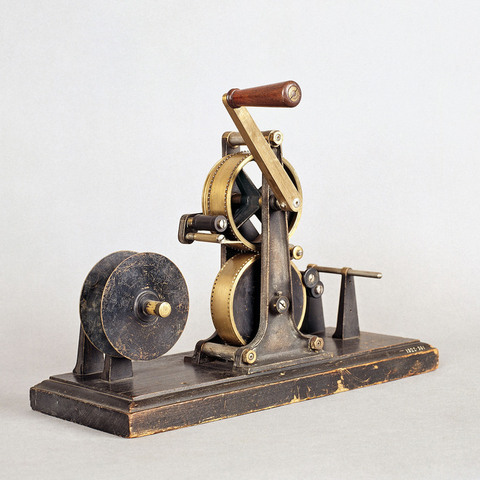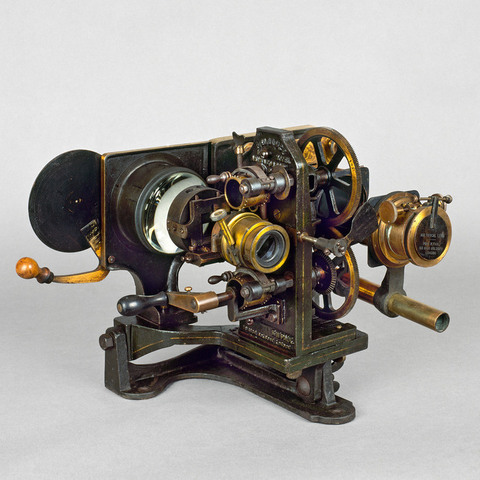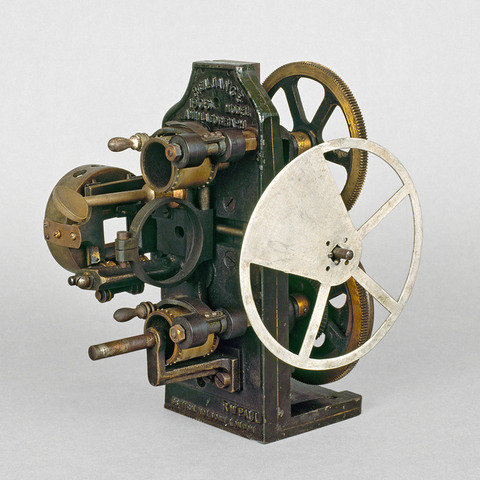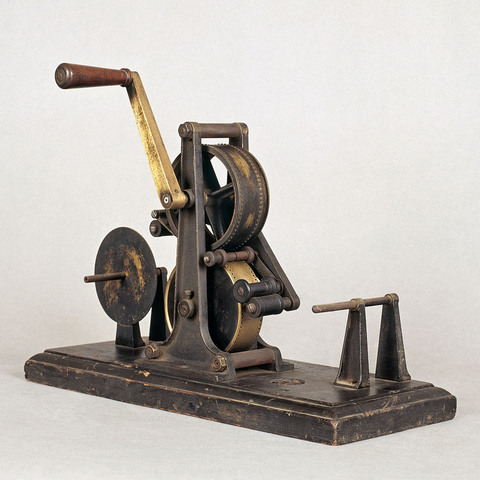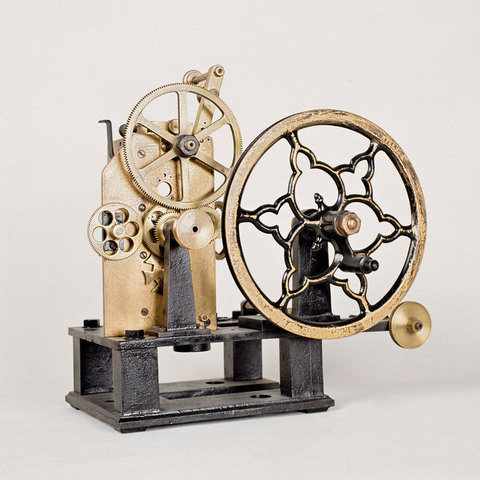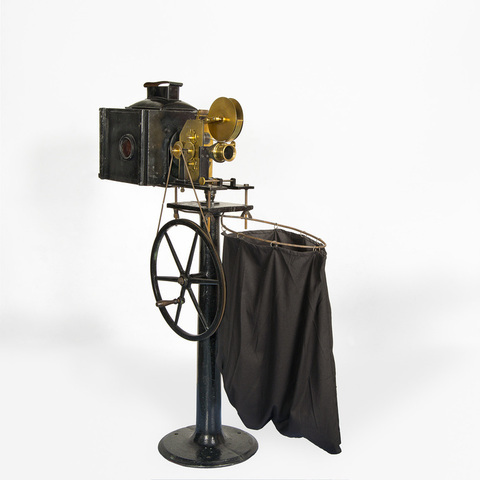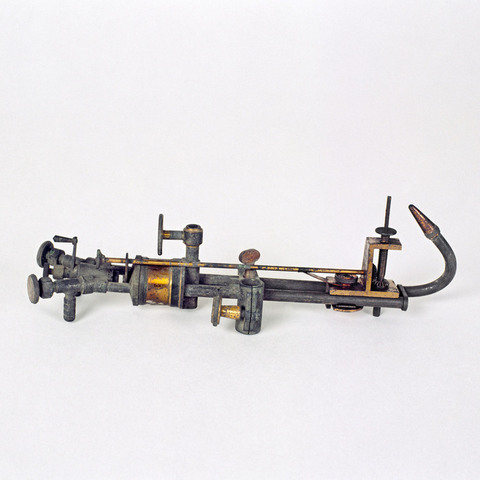Perforatrice de film 35 mm
Fiche détaillée
Type de l'appareil
entraînement du film 35 mm par une roue dentée et une roue creuse ; base en bois ; manivelle
Auteurs
Informations non disponibles
Fabricants
Robert William Paul
Londres, 44 Hatton Garden
Utilisateurs
Informations non disponibles
Distributeurs
Robert William Paul
Londres, 44 Hatton Garden
Sujet du modèle
Informations non disponibles
Objectif
Informations non disponibles
Taille de l'objet
Ouvert :
Informations non disponibles
Fermé :
Longueur : 46 cm
Largeur : 19 cm
Hauteur : 37 cm
Diamètre :
Informations non disponibles
Taille de la boîte de transport
Informations non disponibles
Remarques
Collection Will Day. Deux exemplaires.
R.W. Paul utilise en 1895 une perforeuse 35 mm pour la fabrication des films destinés aux contrefaçons du Kinetoscope Edison (il envoie le 29 mars 1895 un specimen du film perforé et impressionné à Edison). Il commercialise ensuite des perforeuses qui figurent encore à son catalogue en 1904 : "Rotary Film Perforator. This machine is of the simplest possible construction, and there is nothing to get out of order ; when moderate quantities of film only are to be perforated it will be found to answer perfectly well. Spools are provided for the supply of perforated and unperforated film, which may be rapidly perforated with perfect accuracy. Price, complete : £ 20" (R.W. Paul, Animatograph Films Robt W. Paul, Londres, s.d. c. 1904). Une réplique de cette perforeuse à été effectuée par le Science Museum de Londres. Un modèle plus évolué (avec cadran et bras) encore vendu vers 1910 par Walter Tyler (Tyler Apparatus Company, Price List of Cine Studio Apparatus, Londres, s.d., p. 27.)
"From a statement of Paul's, it appears that trials with the first camera had taken place in February 1895, the same month and year in which the Lumière brothers patented their Cinématographe. [...] We have proof that Paul had a workable camera ready by 29 March, for on that date he wrote to Thomas A. Edison, enclosing a sample strip of cinematograph film. The film strip and letter are now in the Edison Museum at West Orange : "Dear Sir, I have taken some interest in your Kinetoscope here, and have found that a demand existed for a greater variety of subjects that [sic] at present available. I have therefore commenced to manufacture films representing recent scenes and events here, and shall be pleased to hear from you if you think our mutual interests would be served by an exhange of films. I enclose for your inspection a small piece of the first film which I have made, thinking it might interest you although I expect to attain even better results with a little pratice. In case you decide to entertain this proposal I shall be pleased to co-operate with you in stopping sundry attempts now being made here to copy your films - which, I take it, is an offence against the international Copyright Act". The letter was answered by Edison on 16 April, rejecting Paul's proposal. [...] The scene shown is the front of Clovelly Cottage, Barnet, the home of Birt Acres who was Paul's cameraman at the time. [...] Paul's letter to Edison and the strip of film enclosed with it also confirm that Paul had devised a satisfactory perforator and printer by 29 March 1895 for, as Gordon Hendricks has pointed out, the sprocket-holes are of the same size and location as those of the Edison film. There must have been a certain amount of trial and error before such perfection was attained, and it seems likely that a February date for these trials would be a conservative one. Concerning the perforating of the films at this time, Paul has this to say : "For perforating the film I made, for use in an ordinary fly-press, a set of punches, 32 in number, with pilot pins, to the Edison gauge". This use of hand punches as a first expedient to perforate the film seems to be borne out by a strip of film in the Will Day Collection of Historical Cinematograph and Moving Picture Equipment. I have not had the opportunity to examining the actual strip, but it is listed and described in the Will Day Catalogue, under item 300, as follows : "Small portion of positive film, being the first film ever taken by Mr R. W. Paul in 1895, and showing a cricketer jumping over the garden gate of Mr Paul's own residence. The perforations are interesting in this film as they were carried out by the use of a 32-toothed hand punch, the film being placed upon a block of lead and the punch being driven through the film with a hammer. Hence the irregularity of the perforations". It is difficult to believe that such accurate perforating as is revealed by the sample strip of film sent to Edison on 29 March 1895 could have been effected by the manual method just described, and we are forced to believe that a more sophisticated method was by then in use, such as a rotaty perforator of the kind now represented in the Science Museum, South Kensington, by a replica made from an original in the Will Day Collection which is ascribed to R. W. Paul, but to the year 1896. A reliable printer must also have been constructed about the same time, although the Paul-Acres camera may have served the purpose in the initial stages. A Paul printer in the Science Museum is also ascribed to the year 1896 and may be contemporary with the perforator. It seems highly unlikely that Paul would suggest to Edison an exchange of films if his own were not of a comparable standard to Edison's, which they certainly would not have been if the perforations were as irregular as Will Day suggests was the case with the hand-punched film. It is reasonable to suppose, therefore, that both the rotary perforator and the printer mentioned above are modified versions of models previously in use as early as March 1895" (J. Barnes, The Beginnings of the Cinema in England, Londres, 1976, pp. 21-23).
Bibliographie
W.Day, Illustrated Catalogue of the Will Day Historical Collection , Londres, s.d. [1934], p. 21.
J. Barnes, The Beginnings of the Cinema in England, Londres, 1976, pp. 21-23.
R.W. Paul, Animatograph Films Robt W. Paul, Cameras projectors & accessories, Londres, s.d. [ 1903 ], (non paginé).
